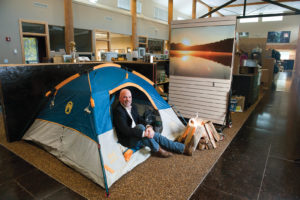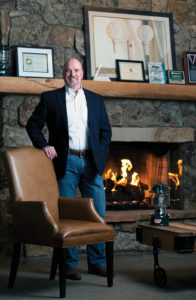
Jeff Schmitt balances the reality of off-shore manufacturing with how to bring production back to the U.S.
“At the end of the day we’ve got to figure out ways to be competitive,” says Jeff Schmitt, senior vice president of operations for The Coleman Company Inc., Golden, Colo. “As the person responsible for both the U.S. and international sides of manufacturing for Coleman, I manage make vs. buy decisions. Any products we manufacture in the U.S. have to competitively win that business based on cost, quality, delivery and safety. And for those products we manufacture off-shore we have to make sure we retain control of the product’s quality.”
Schmitt worked for a variety of organizations before taking a position with Coleman in 2011. He points to each job he’s had as contributing to his leadership capabilities. Undergraduate work in aerospace engineering taught him to think through problems in a logical manner. As a platoon leader in the U.S. Army, Schmitt gained the ability to adapt his leadership style to a variety of people and situations. His takeaway from IBM was process, process, process. At Pitney Bowes, he learned how important it is to integrate the different functions of a business—from sales and marketing to project management, through engineering and including customer service. And at Coleman, he’s honed his understanding of how products fit into retailers around the world and how those products drive value for customers. “I’ve seen big companies and small companies,” he says. “Everything is ultimately pulled together to create a delightful experience for the end user.”
In addition to managing make vs. buy decisions at Coleman—long known for manufacturing stoves, lanterns, coolers and personal flotation devices (PFDs) and now a global organization with a portfolio of brands—his responsibilities also include working with the company’s sales team to develop its demand forecast and managing production at Coleman’s three U.S. factories.
Make vs. buy
Making the decision of whether Coleman products are made off-shore or in the U.S. boils down to how to create the best supply chain that’s supplying the best products in the world to end users, Schmitt says. Because labor was and still is significantly less expensive in Asia, most consumer packaged goods (CPG) are produced off shore. “But some of the trade-offs you have with that are significantly longer lead times and the need to make significant investments in your quality organization to be sure you don’t lose control of the product,” Schmitt says. “A lot of people say that the reason to bring manufacturing back to the U.S. is to improve quality. If they’re saying that, that means they don’t have the appropriate levels of quality coming out of their factories in Asia—which is a situation nobody should ever allow their business to get into.”
 Making reshoring happen
Making reshoring happen
While Coleman still manufactures products in Asia, the company is invested in returning manufacturing to the United States when it makes sense to do so—and Schmitt has had a hand in making that happen in Coleman’s Sauk Rapids, Minn., facility that produces PFDs. As a result of the reshoring efforts that Schmitt is leading, Coleman has expanded the Sauk Rapids factory from about 60 people in 2011 to 270 people to date, and expects it to grow by another 100 to 150 people in the near future as it continues to bring more business back to the plant. “None of our competitors are manufacturing PFDs in the U.S,” Schmitt says. “The way we were able to bring product back to the U.S. is by maximizing the benefit of reduced lead time, which results in increased flexibility to respond to customer demand. You have to be able to have competitive landed cost, and the way we were able to do that was by taking labor content out of the process.”
Taking labor content out of the process does not, however, mean eliminating jobs. “We’ve actually grown jobs in the U.S.,” Schmitt says. “And we’ve done that through the use of automated equipment.”
The vision for automation meant controlling a polyester fabric as it moves at very high rates of speed through the sewing field to achieve the efficiencies needed to hit competitive costing. “When we told the automation manufacturers and suppliers what we wanted to do they said it wasn’t possible,” Schmitt says. “They told us nobody in the U.S. is moving fabric that fast and hitting that many stitches per inch at those quality levels. We took that as a challenge to go out and develop tooling and fixtures and equipment ourselves.”
Coleman’s team developed its own tooling, integrated with smaller Brother machines. The tooling is synchronized so it can move in conjunction with the machine to double or triple the size of the sewing fields. “What we have now is not just one fixture plate moving around; there are moving parts controlled by the machine on that fixture,” Schmitt says. “It allows the operator to set up the sewing job, which means, for instance, placing two pieces of fabric, three pieces of webbing and three buckles in place and hitting ‘Go.’ The machine does everything else to move the parts around as needed.”
A lot of people say that the reason to bring manufacturing back to the U.S. is to improve quality. If they’re saying that, that means they don’t have the appropriate levels of quality coming out of their factories in Asia—which is a situation nobody should ever allow their business to get into.
—Jeff Schmitt
Integrated design
Designing the automation involved several different tiers of employees. The process began with an engineering team designing tooling and fixtures that met the requirements from a cost, quality and delivery perspective. “The engineers are great, but they’re not necessarily experts in sewing,” Schmitt says, “so we involved our maintenance team. We have a great team of maintenance technicians that have really evolved their skill sets as we’ve grown the business.”
For Coleman to develop its automated processes to meet or exceed quality requirements, it was necessary to involve quality experts and the operators. Much of the process meant talking with the operators, showing them the concepts of what the tooling and fixture were going to look like, and compiling their feedback on how they think equipment would be best operated.
“For example, sewing machines have always been foot-operated, so we designed the controls on the floor as foot pedals,” Schmitt says. “But the operators told us it would be faster for them to use hand actuators located on the machine directly adjacent to the fixtures. Instead of having to put the fabric, webbing and buckles on the machine, back up and then look down to see where the foot pedal is, they said it would be easier to put the actuator right next to the fixture.”
Closely related to operational efficiency is the focus on minimizing repetitive stress injuries for operators. “We have put focus not only on the immediate safety of our operators but also on designing processes that minimize the risk of repetitive stress injuries,” Schmitt says. “In addition to the hand button, we also ensure that the machine and operating surface is at the right height for the employee so they’re not reaching too far or bending over. And instead of using large tables with piles of fabric or buckles, we have adjustable bins connected to the tables.”
 Automation and growth
Automation and growth
Schmitt admits that transitioning to a more automated process can understandably cause anxiety among the people who move product through the facility, but that anxiety can turn to support if they’re included in the process and the benefits are made clear.
“First, we explained that the reason we were moving in this direction was that we can bring jobs back to the U.S., so obviously there was a lot of enthusiasm around that,” he says. “And another important element is that we’ve been able to create a set of higher skilled jobs by teaching people how to operate CNC (Computer Numerical Controlled) sewing platforms. They’re learning skills that will help them down the road so they can continue to grow and prosper—whether with Coleman or another company.
“We want this to be a scenario where not only are we growing our business and bringing products back to the U.S., but it’s critical that our employees know that they’re growing with us,” he says. “We really were a 20th century industry that we’re bringing into the 21st century.”
 Snapshot: Life savers
Snapshot: Life savers
One reason Jeff Schmitt is so passionate about his work with The Coleman Company Inc. and its manufacturing facility in Sauk Rapids, Minn., is the protective nature of the products it produces. “Every one of our life jackets has to be UL and U.S. Coast Guard certified—every piece of thread we use, every inch of fabric and webbing,” Schmitt says. “And the finished product itself has to be approved as well. We have to comply with those regulations but we also ensure that we are setting our own internal standards higher than the UL and U.S. Coast Guard certifications, so we know that we’re building the best products possible to keep people safe on the water.”
Under the Stearns® brand, Coleman manufactures a variety of recreational and industrial personal protective items, including the Stearns® Work Zone Gear™ Powerboat™ 1077 jacket. The jacket has 15.5 lbs. (69 newtons) of buoyancy and, to enhance visibility, is ANSI compliant with 3M™ Scotchlite™ SOLAS-grade reflective strips across the chest, arms and shoulders. The company re-designed the jacket to be more comfortable, and the front pockets are expandable for bulky radios and equipment, but retract to a flat surface when not in use.
“Our relationships with our retail customers are extremely important to us,” Schmitt says. “But at the end of the day our focus is on keeping our end users safe and comfortable on the water.”
5 Top Tips: Making automation work
- Don’t use automation to reduce labor. That won’t add value to
the process. - Use automation to increase throughput and the amount
of value for the end user. - Take what exists in the market today and bring it to the next level.
- Include operators in the design process.
- Understand that automation is not only about taking time out of the process but also about creating safer equipment for the operators to use.
Can you talk about how Coleman is seeking an expanded production authority in a Foreign Trade Zone (FTZ) in Sauk Rapids, Minn., to support and expand U.S. manufacturing?
The biggest challenge we face today is that we have this odd situation where there’s a duty and inversion between the fabric that goes into a PFD and the duty that is paid on a finished good coming out of Asia. All of our competitors of any volume pay a duty rate for a finished good of 4.5 percent coming into the U.S. The duty rate we have to pay on fabric coming into the U.S. is 14.9 percent. We’re requesting to bring material in duty-free into this FTZ so we can manufacture the products using all U.S. labor. We’re asking for a level playing field.
How do you acquire skilled workers?
The places in which we operate have very low rates of unemployment so it is a challenge to acquire skilled workers. We work very closely with the best contract service agencies in each of our factories’ locales. We’ve put a process in place to ensure we’re getting the best workers we can by doing in-depth screening before we hire. We set up sewing machines to test employees before we hire them to see if they have the necessary aptitude to operate the equipment. If they pass that testing, we bring them into the facility to show them what it looks like to make sure it’s the type of environment they want to work in. Then we conduct training before we throw them into the production line to ensure that they’re going to be able to hit the efficiency levels we need them to hit. We also make sure the environments are comfortable—cool in the summer and warm and bright in the winter.
 TEXTILES.ORG
TEXTILES.ORG


